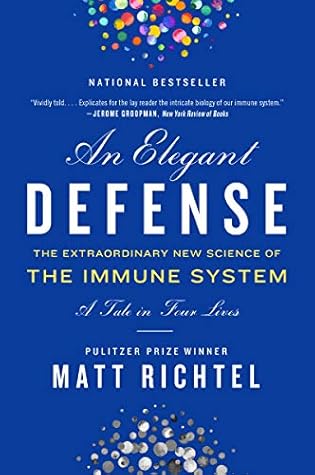More on this book
Community
Kindle Notes & Highlights
by
Matt Richtel
Read between
April 2 - April 22, 2019
Only recently have we begun to understand the pervasive role of our immune system in the brain, where damaged or outdated synapses get pruned by the organ’s own immune cells, allowing ongoing neurological health.
In fact, when we use antibiotics or antibacterial soaps or encounter toxins that harm our gut flora, we risk impairing bacteria that contribute to the effectiveness of our immune system’s function.
Fully 20 percent of the American population, or 50 million Americans, develops an autoimmune disorder.
Diabetes, the leading killer in the country, is caused by the immune system’s going to war against the pancreas.
Smoking tests the immune system like few human habits; the tiny nicks and cuts to the soft lung tissue don’t just create persistent injury but force cells to divide to replace the hurt tissue. Cell division heightens the possibility for malignancy, cancer. This is just simple math, and it can be deadly.
an elegant defense that is out of balance, an immune system that has overcompensated, been triggered to act without proper constraint.
Phagocytosis is the process by which the devouring happens.
“a curative reaction of the organism, and morbid symptoms are no other than the signs of the struggle between the mesodermic cells and the microbes.”
At the moment of invasion, the body has an initial reaction that involves the swarming of eater cells, and the experience is not always pleasant. This is what we call inflammation.
It is an ever-vigilant, omnipresent peacekeeping force in the Festival of Life.
“God had two options,”
“He could turn us into ten-foot-tall pimples, or he could give us the power to fight 10 to the 12th power different pathogens.” That’s a trillion potential bad actors.
Pimples are filled with white blood cells, which are rich with immune system cells (I’ll elaborate in a bit). In short, you could be a gigantic immune system and nothing else, or you could have some kind of secret power that allowed you to have all the other attributes of a human being—brain, heart,...
This highlight has been truncated due to consecutive passage length restrictions.
A major role of the immune system is to keep infection out of our circulatory system.
Survival depends on knowing what is self and what is alien. The immune system must cope with three major challenges: the variability of bad actors, the central circulatory system that sends rivers of blood throughout our body in seconds, and the need to heal.
The B cells came from bone marrow and generated antibodies. The T cells matured in the thymus and could either fight or direct
They are generals and soldiers.
This capability to adapt explains a practical development that is one of the most important life-saving discoveries in our species’s history. Enter the vaccine.
work. It had been doing most of the work—for epochs.
The antibody-encoding genes are unlike all other normal genes.
“Centuries of sloppy observation and self-deception.” It sounds carnivalesque, the stuff of hair tonic salesmen.
An individual’s elegant defense didn’t care
simply about the infection; it cared about the infection when it attacked its own personal habitat.
“Inflammation is—very generally speaking—the body’s immune system’s response to stimulus.”
Pus, it turns out, is the detritus of neutrophils, the cells that rush into action at the first sign of insult.
In fact, many interleukins are designed to be anti-inflammatory. They are immune system brakes, not accelerants. In fact, some of the sets of monocyte cells that help fuel inflammation also have subsets that dampen inflammation. For example, we now know that the IL-1 family has dozens of members, of which many are anti-inflammatory. At least a third of the variations of this key principal immune system protein are designed to stop the immune system from inflaming. “Before antibiotics, these inflammatory cytokines helped kill off infection,” Dr. Dinarello says, and the cytokines still play that
...more


